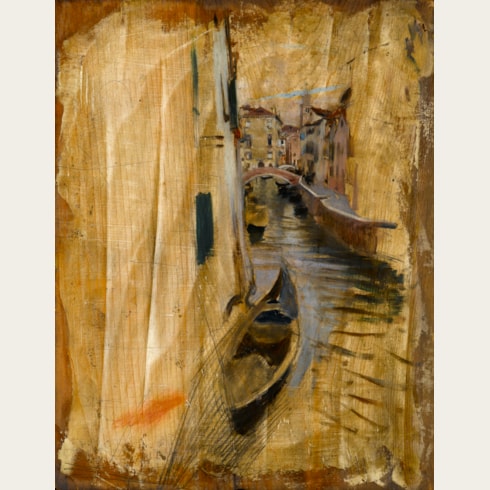Giovanni BOLDINI
(Ferrara 1842 - Paris 1931)
Portrait of a Man Seated in a Church
Stamped with the vente stamp Boldini (Lugt 272b or 272c) at the lower left.
Inscribed 12 - uomo in chiesa and further inscribed (by Emilia Cardona Boldini) no121 atelier Boldini. / Emilia Boldini. - Cardona / 1921 on the verso.
449 x 450 mm. (17 5/8 x 17 3/4 in.)
Boldini produced a number of large-scale watercolours of church interiors in the first two decades of the 20th century. Examples are today in the Museo Giovanni Boldini in Ferrara and the Philadelphia Museum of Art, while several others are in private collections.
It has been suggested that the present sheet may be a portrait of Boldini’s close friend, the caricaturist Georges Gourçat, known as Sem (1863-1934). The artist used the motif of a sitter holding a hand to his or her cheek in a few other works, notably a portrait of Degas now in the Museo Boldini in Ferrara and in a watercolour of a Woman in Front of a Mirror in a private collection in Paris.
The present sheet was acquired from Wildenstein by Baron Maurice de Rothschild (1881-1957), a collector and connoisseur who was a friend of Boldini and came to own several significant works by him.
The son of a minor painter and restorer in Ferrara, Giovanni Boldini arrived in 1864 in Florence, where he enrolled in the Accademia di Belle Arti. He first exhibited his work in Florence in 1867, and in the same year visited the Exposition Universelle in Paris. From the earliest years of his career he displayed a remarkable talent as a portrait painter. During a trip to London in 1870 he obtained several portrait commissions, and by October 1871 he had settled in Paris, taking a studio on the Place Pigalle, and making his public debut at the Salon de Mars in 1874. Boldini’s bold, fluid style of painting was to prove immensely popular in Paris.
In the late 1870’s and early 1880’s he produced genre paintings of elegantly dressed women portrayed in lavish interiors - subjects made popular by Alfred Stevens and James Tissot - and these works found a ready market in England and America through the efforts of the Parisian art dealer Adolphe Goupil. By the time he moved to a new studio in 1885, however, he had begun to paint society portraits, and soon developed a formidable reputation for his dazzling, elegant depictions of the fashionable women of Paris, painted with a virtuoso technique of bold, fluid brushstrokes. Within a few years Boldini had risen to a position of prominence in Parisian art circles. He befriended other society portrait painters such as Paul-César Helleu, John Singer Sargent and James A. McNeill Whistler, and became a close friend of Edgar Degas, who is said to have once told the artist, “Vous êtes un monstre de talent!”.
By the turn of the century Boudin had become the most sought-after portrait painter in Paris, achieving such success that his reputation rivalled that of his friend Sargent in London. His fame reached as far as America, from where he received several portrait commissions, stimulated by an exhibition of his work held at Boussod, Valadon and Co. in New York in 1897.
Boldini was a gifted and somewhat compulsive draughtsman, and filled many sketchbooks with drawings. (He would also use whatever paper came to hand, and there are examples of quick sketches drawn on menu covers, receipts, ledger paper, postcards, hotel stationery, pages torn from auction catalogues, and so forth.) His drawings, characterized by a restless energy and a spirited technique wholly in keeping with the bravura brushwork of his oil paintings, range from quick sketches of figures, landscapes, buildings and objects to more elaborate studies of these same motifs. As Richard Kendall has recently written, ‘Evident in almost all of [Boldini’s drawings] is a vivid engagement with the pleasures of looking and with the nervous exuberance of the drawing process, irrespective of the chosen subject…Some of these drawings would have taken only minutes or even seconds to complete, while others are the work of hours of concentrated labor…This engagement was vividly physical and sensuous, as his hand erupted in wild flourishes of pencil, pen and ink, crayon, and charcoal, or opted for extreme delicacy as the situation demanded.’ The largest surviving group of drawings by Boldini, bequeathed by the artist’s widow, is today in the collection of the Museo Boldini in Ferrara.
Provenance
The atelier Boldini sale, Paris, Galerie Jean Charpentier, 30 June 1936, lot 39 (bt. Wildenstein for 2,000 francs)
Wildenstein and Co., Paris
Baron Maurice de Rothschild, Paris and Switzerland
Thence by descent until 1995
Maurice de Rothschild sale, New York, Christie’s, 1 November 1995, lot 1
P. & D. Colnaghi, London, in 1996
Private collection, London
Anonymous sale, New York, Christie’s, 24 January 2017, lot 124 Private collection, New York.
Literature
Exhibition


















